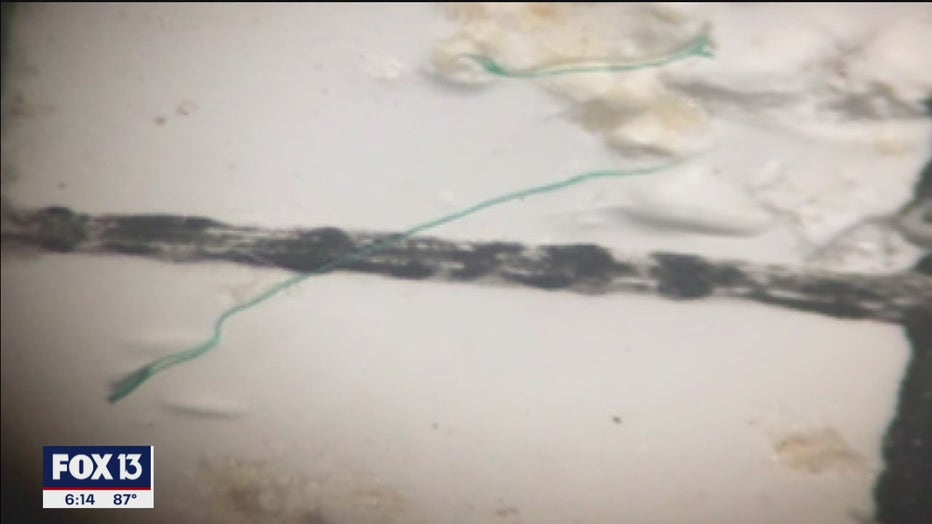Despite progress in Tampa Bay, microfiber pollution devastating sea life worldwide
TAMPA, Fla. - Monday was World Oceans Day, a concept originally proposed in 1992 by organizations in Canada and Brazil.
On World Oceans Day 2020 in Florida, the outlook is mixed. Tampa Bay has seen improving water quality with more seagrass beds and fish. But Florida’s coral reef is in decline because of disease and pollution.
Scientists from Mote Marine Laboratory in Sarasota and the Florida Aquarium in Tampa are working to try and save the reef.
The Florida Aquarium was recently able to get certain types of coral to reproduce in a laboratory for the first time.
Mote Marine Laboratory has had a research operation in the keys for years.
“We do benefit from coral reefs here in Tampa Bay,” says Roger Germann, president and CEO of the Florida Aquarium. “About a third of marine life starts their life or has some connection to those coral reefs.”
Both the Florida Aquarium in Tampa and the Mote Marine Aquarium in Sarasota are now reopened to the public after COVID-19 closures. Scientists say educating the public -- in person -- is a big part of saving the marine environment.
The effect of discarded plastics on sea life continues to be a big concern. A giant parrotfish sculpture outside the Florida Aquarium is covered with plastics that washed ashore, everything from sand pails to flip-flops to soda packages. But one of the newest concerns is plastic that you can’t even see. Scientists say microfiber from clothing made from synthetic materials like polyester is traveling from washers into the oceans and it's being found inside dead sea life.

Microplastic viewed under a microscope
Germann says there is still lots of work to be done, but he’s impressed that Tampa Bay is cleaner now than in decades past.
“Our relationship with our oceans is second-to-none and we need to preserve that for future generations,” he said.
The Surfrider Foundation suggests these 10 steps to prevent microfiber pollution from your home.
- Buy less and buy natural Do you really need yet another new fleece? When possible, consider shifting your purchase choices to natural fibers like organic cotton.
- When possible, consider shifting your purchase choices to natural fibers like organic cotton.
- Use a front-loading washing machine instead of a top-loading washing machine Front loading washing machines shed way less (7X less) microfibers than top-loaders
- Front loading washing machines shed way less (7X less) microfibers than top-loaders
- Wash less, and when you do use cool water A little campfire smell only gives your clothing more character. Washing with cool water won’t make that much of a difference in how clean your clothes come out, and it will avoid the additional shedding from hot water breaking up the fibers.
- A little campfire smell only gives your clothing more character. Washing with cool water won’t make that much of a difference in how clean your clothes come out, and it will avoid the additional shedding from hot water breaking up the fibers.
- Do not wash with solid items (like shoes or backpacks) Heavy items lead to more friction, which means more fibers breaking during washing and ending up in the ocean.
- Heavy items lead to more friction, which means more fibers breaking during washing and ending up in the ocean.
- Separate soft textiles and hard textiles The goal is to have less agitation in the washer and dryer, so separate out the heavy clothing from light clothing.
- The goal is to have less agitation in the washer and dryer, so separate out the heavy clothing from light clothing.
- Avoid using a tumble dryer, air-dry instead Synthetic clothing air drys fast anyway and the dryer may also contribute to microfiber release.
- Synthetic clothing air drys fast anyway and the dryer may also contribute to microfiber release.
- Reduce rotation speed when washing Skip the spin cycle to prevent additional friction from causing more fibers to break.
- Skip the spin cycle to prevent additional friction from causing more fibers to break.
- Wash for a shorter amount of time The more time in the washer, the more chances for microfibers to escape.
- The more time in the washer, the more chances for microfibers to escape.
- Use less detergent and without bleach Liquid detergent is best and use it sparingly.
- Liquid detergent is best and use it sparingly.
- Consider using a filter/microfiber system
Though these devices are not an end-all solution, they provide an intermediate option to reduce the amount of microfibers that go down the drain -- and are great ways to raise awareness about the issue.
The Guppyfriend is a bag that you place your synthetic clothes in when you wash them. It catches microfibers that may shed from synthetic clothing, but more importantly, it reduces the level of agitation in the washer, a significant factor in microfiber release.
The best solution to catch microfibers in your laundry is an actual filter attached to your washer. Recent studies have shown that filters like Lint LUV-R and Filtrol 160 have a catchment rate of up to 87% of microfibers.


